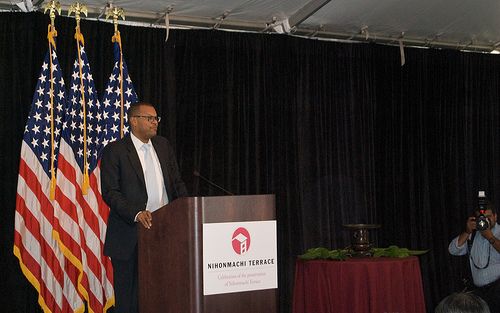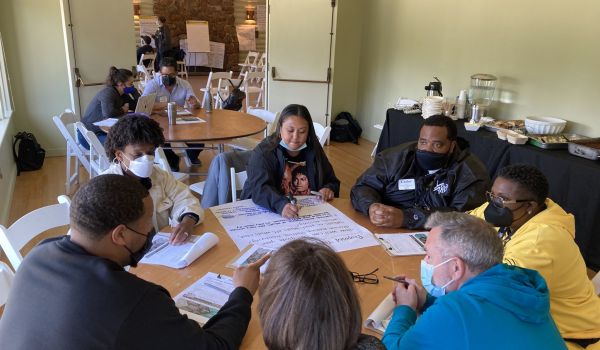In this week’s Forefront story, journalist Josh Stephens took a close look at California Gov. Jerry Brown’s decision to dissolve the state’s 400-odd urban redevelopment agencies, and what the collapse of the $5.6 billion-a-year system means for cities. Today, Next American City talks to Fred Blackwell, the city administrator picking up the pieces in Oakland.

Fred Blackwell is reinventing Oakland’s redevelopment program. Credit: Steve Rhodes on Flickr
Blackwell, an Oakland native, moved to Mayor Jean Quan’s City Hall in October 2011, just as the rails were coming off the state’s redevelopment program. He came to Oakland fresh from San Francisco, where he had served as director of that city’s redevelopment agency under former mayor Gavin Newsome. During his time in San Fran, Blackwell played a major role in the transformation of the Hunters Point Naval Shipyard and military base into a 700-acre, $8 billion neighborhood of homes, parkland, offices, retail, arts and community spaces. The project stands as the largest redevelopment effort in San Francisco since the 1906 earthquake. To pay for the project’s infrastructure, the city relied on tax increment financing (TIF), the tool laid to rest with Brown’s decision to dissolve the state’s financing agencies.
Next American City: What does the loss of redevelopment funds mean for Oakland?
Blackwell: It’s losing programs and projects but also losing administrative resources. We have to reorganize the city. We lost 21 employees that were spread all throughout City Hall.
We have to create new departments and a new vision.
NAC: And how much money exactly is at stake for the city? How much a year did the redevelopment agency’s tax increment financing deals bring Oakland?
Blackwell: We got $100 million to $150 million a year in TIF money.
NAC: Wow. How does that compare to the city’s general operating budget?
Blackwell: Well, our annual operating budget is close to a billion. It’s a significant chunk, a very significant chunk.
NAC: How does that amount compare to what Oakland gets every year in entitlement Community Development Block Grants? I ask because CDBG funds are what many cities that don’t have TIF rely on for revitalization projects.
Blackwell: Oakland was earning more from TIF than CDBG. So was San Francisco. It was our main source of financing for affordable housing, infrastructure and façade improvement programs.

The TIF-aided redevelopment of Hunters Point is the largest project in San Francisco since the 1906 earthquake. Credit: Kevin Collins on Flickr
NAC: Are there major projects in Oakland that are limbo because of the dissolution? Can you name one?
Blackwell: We were looking at financing the infrastructure for a new ballpark being financed by Major league Baseball. Victory Court. That is off the table right now. Without TIF, that project becomes very very difficult.
NAC: Tell me about a project in Oakland that wouldn’t have happened without TIF.
Blackwell: There are too many to name. Pretty much all the façade improvements in the city. A lot of affordable housing. Every year, between $5 and $10 million in TIF supported affordable housing in areas where affordable wouldn’t necessarily have happened. A lot of what Jerry Brown did as mayor would not have happened without TIF.
NAC: What’s next? How will Oakland do these revitalization projects without TIF?
Blackwell: Public-private partnerships. We’ll have to think up new ways to work with the private sector. We’ll have to use regulatory tools to incentivize investment. We’ll have to rezone, and we’ll have to be more aggressive and more creative. More aggressively creative.
NAC: Is this the death knell for publicly funded revitalization?
Blackwell: No. I am confident we will rebound. We’ll rise to the occasion.

Downtown Oakland at night. Credit: Lucinaut on Flickr
NAC: Do you think the legislature will come in with new sources of revenue money for cities?
Blackwell: We are working on that. I think so. But as to when, let’s just say I’m not holding my breath.
NAC: Some say the dissolution of redevelopment is a good thing because the redevelopment agencies bred wasteful spending and corruption.
Blackwell: That is something you have to look at on a case-by-case basis. There are always cases where development may have occurred anyway, or abuse take place, but I think those were exceptions rather than the rules. And if you look at any branch of government, you can find bad actors and polices weren’t effective. But that doesn’t mean, say, that fire departments or schools need to go away. I think the decision was an overreaction to a small problem.
NAC: Other critics say the program amounted to an expensive game of musical chairs, because developers would pit localities against each other and move according to whomever gave them the best deal, but in the end the same development came to regions. What is your response to that notion?
Blackwell: That doesn’t go away with the loss of redevelopment. Localities will still be competing. And companies will still be finding subsides and pursuing them any way they can.
Ariella Cohen is Next City’s editor-in-chief.
Follow Ariella .(JavaScript must be enabled to view this email address)
















